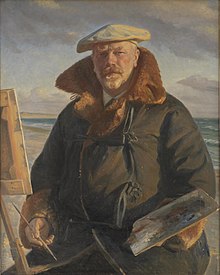

Michael Peter Ancher (9 June 1849 – 19 September 1927) was a Danish realist artist, widely known for his paintings of fishermen, the Skagerak and the North Sea, and other scenes from the Danish fishing community in Skagen.


Michael Peter Ancher (9 June 1849 – 19 September 1927) was a Danish realist artist, widely known for his paintings of fishermen, the Skagerak and the North Sea, and other scenes from the Danish fishing community in Skagen.


Michael Peter Ancher was born at Rutsker on the island of Bornholm in the Baltic. The son of a local merchant, he attended school in Rønne but was unable to complete his secondary education as his father ran into financial difficulties, forcing him to fend for himself. In 1865, he found work as an apprentice clerk at Kalø Manor near Rønde in eastern Jutland. The following year, he met the painters Theodor Philipsen and Vilhelm Groth who had arrived in the area to paint. Impressed with his own early work, they encouraged him to take up painting as a profession. In 1871, he spent a short period at C.V Nielsen's art school as a preliminary to joining the Royal Danish Academy of Art in Copenhagen later in the year. Although he spent some time at the academy, he left in 1875 without graduating. [1]
One of his student companions was Karl Madsen who invited him to travel to Skagen, a small fishing village in the far north of Jutland where Skagerak and North Sea converge. From the mid-1870s, he and Madsen became key members of a group of artists who congregated there each summer, known as the Skagen Painters. [2]
After Ancher first visited Skagen in 1874, he settled there joining the growing society of artists. The colony of painters regularly met in the Brøndums Hotel in Skagen in order to exchange ideas. In 1880 Ancher married fellow painter and Skagen native Anna Brøndum, whose father owned the Brøndums Hotel. In the first years of their marriage, the couple had a home and studio in the "Garden House", which is now in the garden of the Skagens Museum. After the birth of their daughter Helga in 1883, the family moved to Markvej in Skagen. [2]
He achieved his artistic breakthrough in 1879 with the painting Vil han klare pynten ( Will He Round the Point? ). Michael Ancher's works depict Skagen's heroic fishermen and their dramatic experiences at sea, combining realism and classical composition. Key works include The Lifeboat is Carried Through The Dunes (1883), The Crew Are Saved (1894) and The Drowned Man (1896). [1] [2]
Michael Ancher was influenced by his traditional training at the Royal Danish Academy of Fine Arts in the 1870s which imposed strict rules for composition. His marriage to Anna Ancher did, however, introduce him to the naturalistic concept of undecorated reproduction of reality and its colours. By combining the pictorial composition of his youth with the teachings of naturalism, Michael Ancher created what has been called modern monumental figurative art, such as A Baptism. [3]

Among other places, the works of Anna and Michael Ancher can be seen at the Skagens Museum, Statens Museum for Kunst , the Frederiksborg Museum, The Hirschsprung Collection, and Ribe Art Museum. Michael Ancher received the Eckersberg Medal in 1889 and in 1894 the Order of the Dannebrog. Originally many of Ancher's paintings hung in the dining room of the Brøndums Hotel. The painter P.S. Krøyer conceived the idea of placing paintings by different artists in the wall panels. In 1946 the dining hall was moved to Skagens Museum. [2]
The Skagen residence of Anna and Michael Ancher was purchased in 1884. In 1913, a large studio annex was added to the property and this also forms part of what is on display today. Upon her death in 1935, their daughter, Helga Ancher, left the house and all of its contents to the Helga Ancher Foundation.
In 1967 the home was turned into a museum, the Anchers Hus. The original furniture and paintings created by the Anchers and other Skagen artists are shown in the restored home and studio. Temporary art exhibitions are arranged in Saxilds Gaard, another building on the property. This house is filled with displays of paintings by Michael and Anna Ancher as well as those by many other Skagen painters who made up their circle of friends. Today the house is a part of Skagens Kunstmuseer.
Anna and Michael Ancher were featured on the front of the previous series DKK1000 bill. The first version of the bill came into circulation on 18 September 1998, and was then updated on 25 November 2004, adding more security features. The front of the banknote featured a double portrait of Anna and Michael Ancher, derived from two 1884 paintings by Peder Severin Krøyer [4] [5] which originally hung on the walls in the dining room at Brøndums Hotel.
A collection of almost 4,000 letters between Michael and Anna Ancher and their friends, with comments by the art historian Elisabeth Fabritius, was published as Anna og Mchael Ancher. Breve og fotografier 1866-1935 I-VI was published by Forlaget Historika. in 2020. [6]

Skagen is the northernmost town in Denmark, on the east coast of the Skagen Odde peninsula in the far north of Jutland, part of Frederikshavn Municipality in Nordjylland, 41 kilometres (25 mi) north of Frederikshavn and 108 kilometres (67 mi) northeast of Aalborg. The Port of Skagen is Denmark's main fishing port and it also has a thriving tourist industry, attracting 2 million people annually.

Peder Severin Krøyer, also known as P. S. Krøyer, was a Danish painter.
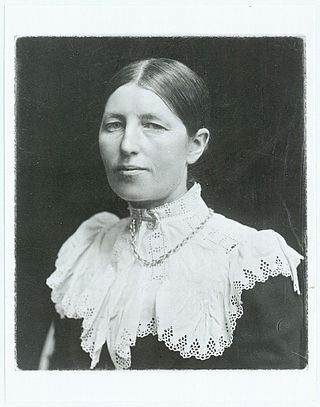
Anna Ancher was a Danish artist associated with the Skagen Painters, an artist colony on the northern point of Jylland, Denmark. She is considered to be one of Denmark's greatest visual artists.
The 1997 series of Danish Banknotes are part of the physical form of Denmark's currency, the Danish Krone (kr.), issued by Danmarks Nationalbank. The 1997 series commenced in March 1997 and has since been replaced by the 2009 series.

Carl Locher was a Danish realist painter who from an early age became a member of the Skagen group of painters.

The Skagen Painters were a group of Scandinavian artists who gathered in the village of Skagen, the northernmost part of Denmark, from the late 1870s until the turn of the century. Skagen was a summer destination whose scenic nature, local milieu and social community attracted northern artists to paint en plein air, emulating the French Impressionists—though members of the Skagen colony were also influenced by Realist movements such as the Barbizon school. They broke away from the rather rigid traditions of the Royal Danish Academy of Fine Arts and the Royal Swedish Academy of Arts, espousing the latest trends that they had learned in Paris. Among the group were Anna and Michael Ancher, Peder Severin Krøyer, Holger Drachmann, Karl Madsen, Laurits Tuxen, Marie Krøyer, Carl Locher, Viggo Johansen and Thorvald Niss from Denmark, Oscar Björck and Johan Krouthén from Sweden, and Christian Krohg and Eilif Peterssen from Norway. The group gathered together regularly at the Brøndums Hotel.

Hip, Hip, Hurrah! is an oil-on-canvas painting from 1888 by Danish painter Peder Severin Krøyer.

Carl Johan Wilhelm Madsen, commonly known as Karl Madsen, was a Danish painter and art historian with close connections to the Skagen Painters.
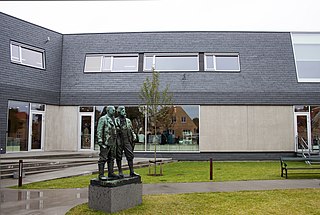
Skagens Museum is an art museum in Skagen, Denmark, that exhibits an extensive collection of works by members of the colony of Skagen Painters who lived and worked in the area in the late 19th and early 20th centuries. Important artists include Marie and P. S. Krøyer, Anna and Michael Ancher, Laurits Tuxen, Viggo Johansen, and Holger Drachmann. The museum also hosts special exhibitions. Its facilities include a café in the Garden House, an old building which for a while served as home residence and studio of Anna and Michael Ancher.

Anchers Hus is an art museum and gallery situated in the former residence of the painters Michael and Anna Ancher in Skagen, Denmark. Anchers Hus is located on Markvej in Skagen, Denmark.

Brøndums Hotel, in the little harbor town of Skagen in the north of Denmark, is remembered for its close associations with the late 19th-century artists colony known as the Skagen Painters. It still operates as a hotel today.

Christen Degn Brøndum was the proprietor of Brøndums Hotel in Skagen, Denmark, which was closely associated with the Skagen Painters.
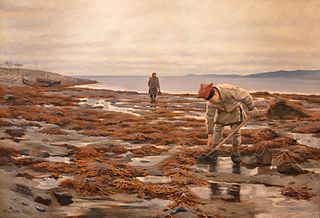
Wilhelm Otto Peters was a Norwegian painter who participated in the Modern Breakthrough in Nordic painting. He associated closely with the Skagen Painters in the early 1880s and was one of the first to paint the fishermen in Brøndums store.

Will He Round the Point? is an 1880 oil-on-canvas painting by Michael Ancher, a Danish painter associated with the Skagen Painters. The painting is particularly notable as Ancher sold it to Christian IX of Denmark, bringing Skagen and its artistic community to wider attention.
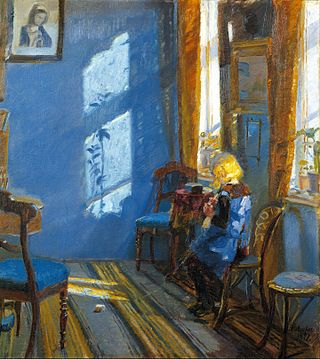
Sunlight in the Blue Room is an 1891 painting by Anna Ancher, an innovative Danish painter who was a central figure with the Skagen Painters. With its many shades of blue and the sunlight pouring through the window, the painting is one of her most prominent works.

Midsummer Eve Bonfire on Skagen Beach is a 1906 painting by the Danish artist P.S. Krøyer. The large work, which took several years to complete, shows many of the artists in the group known as the Skagen Painters as well as influential members of Skagen's local community.

Launching the Boat. Skagen is an 1884 painting by the Swedish artist Oscar Björck. It depicts the activities of the local fishermen, a favourite subject for the Skagen Painters. Launching the Boat is the largest of Björck's open-air paintings from Skagen. It is on display in Skagens Museum.

Peder Severin Krøyer painted various portraits of his wife, Marie Krøyer née Triepcke, a fellow Danish artist who was said to be one of the most beautiful women in Copenhagen. Norwegian-born Peder had met and painted Marie in Copenhagen but fell in love with her when they met in Paris in 1889. After a honeymoon in northern Jutland and Italy, the couple settled in Skagen on the northern tip of Jutland in 1891, joining the group of artists that became known as the Skagen Painters.

Helga Cathrine Ancher (1883–1964) was a Danish painter. As the daughter of Anna and Michael Ancher, she was closely associated with the Skagen Painters. Most of her paintings were of her family and friends in Skagen and of local landscapes.

Portrait of My Wife, the Painter Anna Archer is an 1884 painting by Michael Ancher, now in the Hirschsprung Collection.